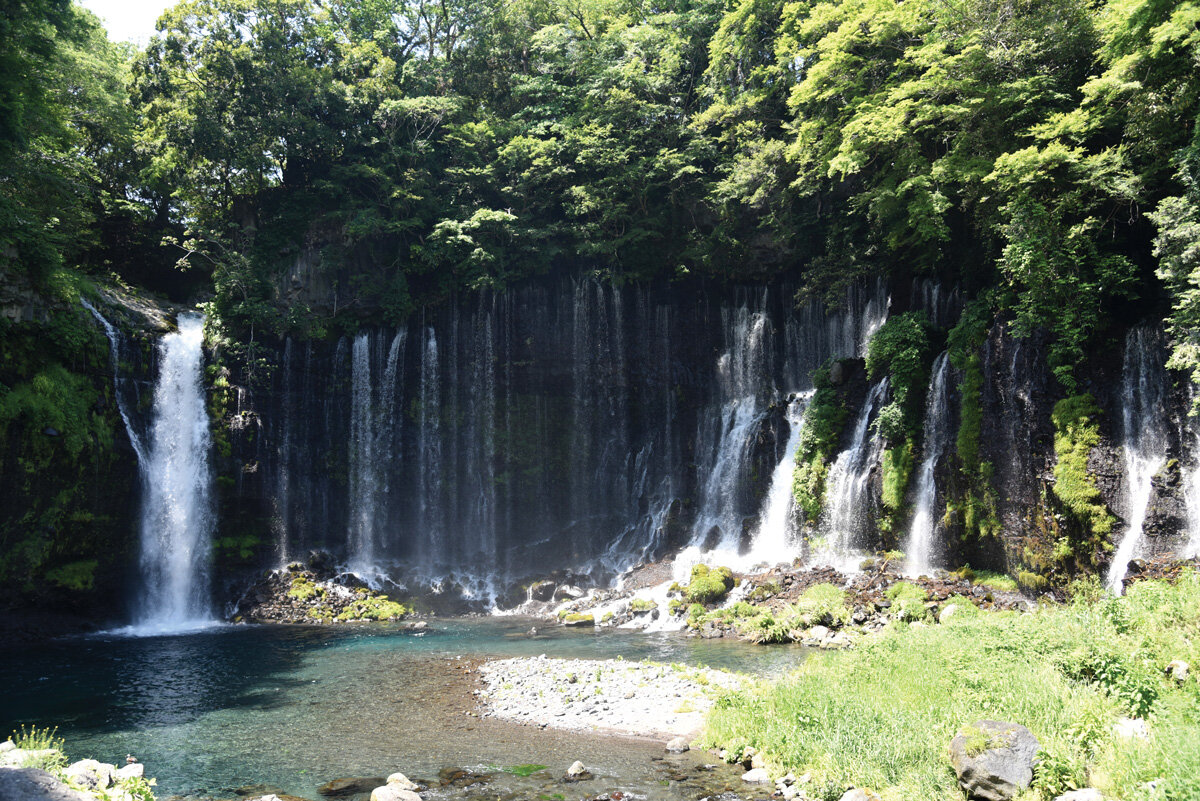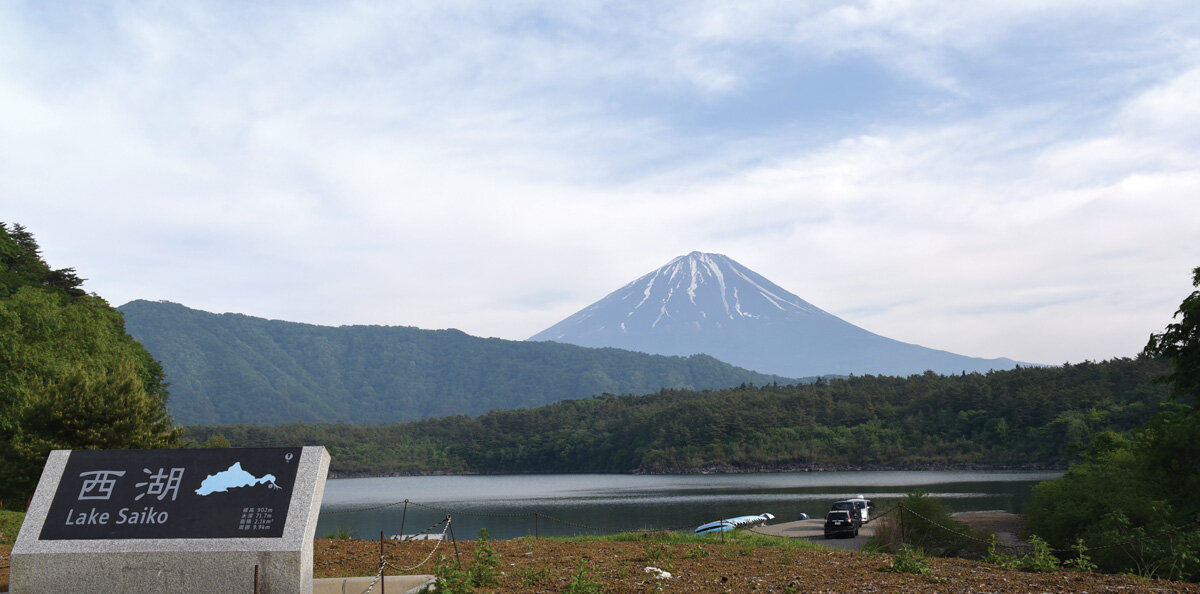Japan 2019: Part 4: Views of Mount Fuji

The design of manhole covers in Japan are always intricate and beautiful. As to be expected the ones at Shin-Fuji station are appropriately Mt Fuji inspired.
After leaving the Hamamatsu area we took a short train trip across to the other side of the Shizuoka prefecture to Shin-Fuji. Shin-Fuji is one of the most easily accessible spots to view Mount Fuji from, being on the main Shinkansen line that runs between Tokyo and Kyoto. On previous trips to Japan we had only seen Mount Fuji glimpsed from the train but this time we hoped to get a much closer look and we had booked a car hire for the next few days to explore the area around Mount Fuji.
On the road leaving Shin-Fuji to head closer towards the mountain.
As we got off the train we could already see Mount Fuji poking out, framed by the window on the train station platform. It was a promising start indeed and for the next two days Mount Fuji would be our constant travelling companion. For my husband, who loves driving, this would be the highlight of his trip, exploring along the roads as we looped in a big circle around the mountain.
Geoff enjoys his passion for driving…
… whilst I enjoy my passion for waterfalls.
Our first stop was up the western side of the mountain which is a little less explored then the more popular eastern side. As an avid waterfall lover I wanted to see Shiraito Falls which is the most famous of the numerous waterfalls to be found in this region. The falls are indeed beautiful, both high and wide the water spills down amidst mossy rocks from beneath a canopy of trees.
The beautiful Shiraito Falls
On arriving you descend down the same side as the falls before crossing the river to the viewpoint at the base of the falls. If you continue up the path on this opposite side then you are rewarded with a view of both the waterfall and Mount Fuji together and there is a loop path back to the carpark from this side as well.
Mount Fuji viewed rising above Shiraito Falls.
Whilst I could have happily stayed here for many more hours soaking up the cool refreshing spray of the waterfall there was still much more waiting to be discovered. We continued to head north up the western side and stopped at Fuji Milkland for a lunch of soba noodles served carbonara style and for Aiden to experience making butter - an experience which involved vigorously shaking a bottle half filled with milk until it started to curdle and then straining it out to make a butter. We bought some gelato made from the milk of the cows before meeting the cows. Sadly the spotty cow sponge cake roll we had hoped to buy here was already sold out so we had to settle for a regular cheesecake instead. As adults my husband and I found the place rather strange with the Texan Wild West music being played throughout the farm and an overall sense of decline permeating some of the spaces. Travelling with a young five-year old though it made an interesting enough stop and we did enjoy the noodles and gelato.
Meeting the milk cows at Fuji Milkland
A statue of the Goddess of Mercy riding a cow at Fuji Milkland. This was significant for us as my husband follows the branch of buddhism that pays respect to the Goddess of Mercy by not eating any beef.
Mt Fuji at Lake Motosu
The Mount Fuji area is famous for it’s five lakes that have formed part of the classical repertoire of scenery in Japanese poetry and art. As an art-lover I was certainly drawn to the concept of visiting the five lakes as part of our tour.
Our first lake we stopped at was Lake Motosu. Of all the lakes this is the least explored by tourists as public transport here is scant. In the car though it was perfect as there is a full circle road around the lake to follow, however this is only a small spot along the way to park and take in the view. Of all the lakes it was also our favourite because of that sense of tranquility and the main vantage point also offered another perfectly classical Japanese element - a spectacular pine tree so it was to me one of the most perfect views of Mount Fuji as we could capture the lake, the mountain and the pine tree all together.
Mount Fuji viewed from Lake Motosu
The next lake along is Lake Shoji which is accessible by a more regular bus route and also a much larger carpark and accommodation options. Lake Shoji is smaller and less expansive than Lake Motosu.
Panorama views of Mt Fuji at Lake Motosu
Scenes driving between Lake Motosu and Lake Shoji
Mount Fuji viewed from Lake Shoji.
By this stage we were moving now across the Northern side of Mount Fuji to take in the next lake along the way - Lake Saiko.
Mount Fuji viewed from Lake Saiko.
Our final lake for the day was Lake Kawaguchi where we would be staying the night. The sun was starting to set when we arrived so it was time to check in to our hotel and relax a little before dinner. Of all the lakes this is the most popular as it is accessible by the train route into Kawaguchiko and there are many hotel options here as well as being the largest town in this area. It is also known as a more reliable spot to view Mount Fuji than Hakone. We stayed at the Fuji View hotel which lived up to its reputation of offering good views of Mount Fuji, though compared to some of the other hotels we stayed at, it wasn’t our favourite.
Lake Kawaguchi.
Mount Fuji viewed from our hotel located next to Lake Kawaguchi
For dinner we wanted to try something quite regional and our research led us to Sanrouken for Yakiniku - Japanese BBQ. It was the perfect choice and the ambience was exactly what we had hoped to find but even more so. The inn is very old and traditional and you feel like you’ve stepped back in time as a traveller following in the footsteps of the Tokaido trail. You sit around a large fire pit and choose a basket of ingredients to roast over the charcoal which makes for a simple yet delicious meal. At the end of the meal hoto noodle soup is served that is rich and warming - perfect for a cold night amidst the lakes and mountains and another local speciality of the region.
Dinner at Sanrouken in Kawaguchiko
The gardens of Fuji View Hotel.
Early morning walk along Lake Kawaguchi
Whilst we might not have loved the styling and decor of our room at the Fuji View hotel - you are clearly paying for the vantage point from your window than for anything inside the room itself - the hotel does have a beautiful expansive garden to explore. I enjoyed waking up early in the morning to admire Mount Fuji and take a walk through the gardens down towards the Lake Kawaguchi. The hotel is close to the Sakuya Bell of Love at the end of a spot on this southern side of the lake that juts out enough for you to turn around and capture a view of both the lake and the mountain together. It was at this point as well that Mount Fuji was starting to gather it’s famous cloud top. By the time we left Kawaguchiko the cloud top was firmly established but we could still see the middle section for a while longer. It was a really special and fascinating experience to watch this cloud take form and see how it transformed the view of the mountain.
Mount Fuji gathering its famous cloud top at Lake Kawaguchi, viewed with the Sakuya Bell of Love.
Mount Fuji with it’s cloud top cover as viewed from Kawaguchiko where the street signs are shaped like little Mt. Fuji’s
The fifth and final lake on our five lakes driving tour was Lake Yamanaka on the North East corner of our Mt Fuji circuit. Swan boats seemed to be a prominent attraction here, we could see some smaller boats stored away waiting for the peak summer season to start and across the other side of the lake we could see a much larger swan lake cruise going around. We had plans to explore around Hakone though, so we headed south into the mountains on the eastern side of Mt Fuji to make our way there.
As Hakone is an easy day trip from Tokyo by train it is the most popular of the spots along our Fuji tour and also the one place we had been before. True to our experiences of previous trips to Hakone this was the one spot where we could no longer see Mount Fuji as by this stage the clouds had fully gathered and swallowed the mountain up. We had bid farewell to the mountain.
The last view we saw of Mt Fuji on our trip as we headed up through the Mt Hikuni pass to Gotemba
Our visit to Hakone was tinged with a sense of eery foreboding. The volcanic Mt Hakon had weeks earlier recorded an increase in volcanic activity and sulphurous rumblings had seen the popular ropeway over the crater closed until further notice. Whilst we had initially planned to take the ropeway for Aiden to experience, Geoff and I had done this on a previous trip and we were here in Hakone for the art galleries and for bathing in the hot spring waters.
The Okada Museum of Art
First stop in Hakone was to the Okada Museum that had opened since our last visit. This impressive museum boasts a collection of Chinese and Japanese ceramics, Japanese folding screens, lacquerware, textiles and stoneware. They have a very strict no photography policy and all cameras and phones are confiscated at entry and locked away for the duration of your visit.
We had a lunch of noodles in the gardens of the museum overlooking a lovely tea garden and small water feature that is built in against the slopes of the volcano. Over lunch we could hear the occasional low melodious boom which we later discovered was actually cannon fire but at the time it felt like an ominous rumble from the volcano which left us pondering why such an impressive art collection would be located right on the slopes of a very active volcano!
For me a trip to Hakone wouldn’t be complete without a stop at the Pola - if only just to gaze on a rather fabulous rendition of the Japanese bridge over the waterlily pond by Claude Monet. I think it is one of the prettiest of this series that Monet did and the museum boasts many other nice pieces in its collection of predominately Western Impressionist paintings. The entrance to the museum is also one of the most beautiful as well, set in amongst the trees. We enjoyed a nice afternoon tea here and both Aiden and I ordered the same dish - fruits in jelly designed to evoke Monet’s waterlily pond.
Keen to relax after our two art museum explorations it was time to check into our accomodation for the next two nights - Kai Sengokuhara. Sengokuhara is a quiet corner at the furthest end of Hakone which makes it a peaceful haven away from the busier areas around the train line. We absolutely loved our hotel from the moment we stepped through the doors to be greeted by the friendly staff with refreshing drinks. Of all the places we stayed this was the most expensive two nights but absolutely worth it. Our room was spacious, beautifully designed and very comfortable for the three of us with the widest bed we’ve ever seen, a walk in wardrobe to keep all the clothes, luggage and shopping neatly out of the way, a lounge area, bathroom and balcony with our own private hot spring tub overlooking the maple trees.
The experience of the hotel wasn’t limited to our room though with very nice communal bath areas to enjoy complete with refreshing fruit ices and iced green tea to rehydrate your body after dunking in the hot spring waters. A full kaieseki dinner is included in the room rate and each dish was superb, beautifully presented and delicious to eat and our son was well looked after with his own special bento set of little things.
Some of the delights served at dinner on Night One of our stay at Kai Sengokuhara
The spread at breakfast was equally interesting and beautifully presented.
Some of the delights served at dinner on Night Two of our stay at Kai Sengokuhara
Kai Sengokuhara is part of a group of hotels run by the Hoshinoya group (the same group whose budget chain Omo we were so impressed with back in Tokyo) and the Kai chain is the group of hotels built around different hot springs experiences. Each Kai resort also has a focus on a particular arts or crafts tradition. At Kai Sengokuhara it was about Tenugui wrapping cloths and either before or after dinner you could sit down, choose a design and decorate it with wax crayons before they carefully wrap it up with instructions on how to iron it back home to set the colours into the cloth. The inner artist in me happily enjoyed this activity after dinner each night and found it a relaxing way to unwind (even if wax crayons on fabric are far more annoying to control than watercolours).
The next day we were due to return the car so we drove back down the mountain to return our rental at Mishima on the South East side of Mount Fuji, completing our circle of Fuji. Though we didn’t see Fuji today we were content with the experience we had of the mountain, when we had turned our back on the mountain to climb up to Hakone so too had the mountain turned her back on us for the remainder of the trip.
A planned stop at Clematis no Oki which is a complex of smaller art galleries, cafes and gardens ended in disappointment as I had somehow missed the memo that the entire complex was closed on Tuesdays (I had thought it was just one of the museums and not everything else) . We glimpsed a few clematis flowers in bloom at the entrance and headed on to Mishima to make our way back up to Hakone via the more common public transportation route. For our train-loving son it was a key part of our planning that he could experience the joy and interest of the switch back train running from Odawara to Gora and then a short ride up the Furnicular to catch the bus back to Sengokuhara and our accommodation.
The next morning it was time to check out of our beloved hotel room, bid the hot-springs, mountains and green leaves behind us and make our way back to Tokyo for one final night’s sleep in Ginza before our flight home the next evening. As we had opted not to go for a JR pass this trip we took advantage of the freedom to choose some interesting alternatives and we took the Romance Car back to Tokyo - if you are buying individual tickets then this is far more economical than the main JR Shinkansen line and you can catch the express right from Hakone-Yumoto station which is where the switchback connects to the Odawara line. The train is a vibrant orange colour with massive windows for scenic viewing and my son loved his special train bento box which he then used in pre-school to take his morning tea in. Trains definitely are more impressive in Japan!
The Romance Car from Hakone to Tokyo and matching kids bento box lunch.






































